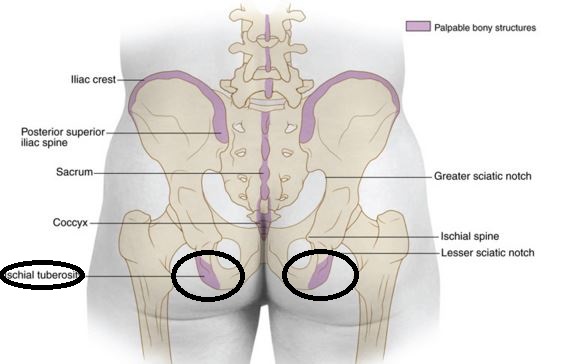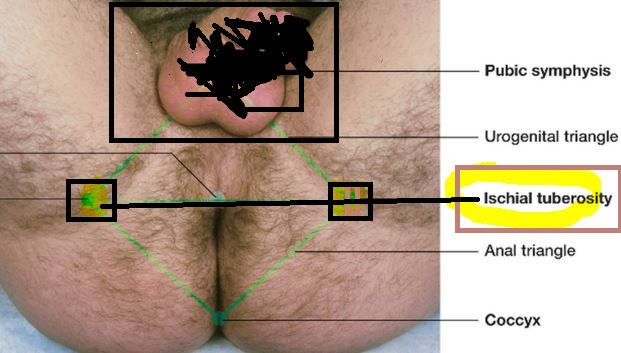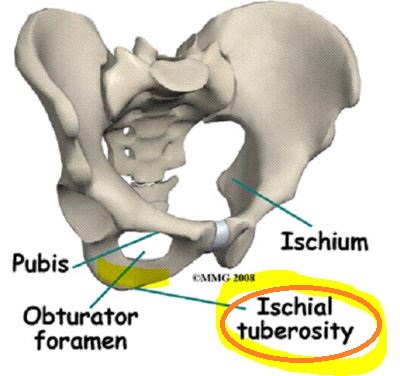Ischial Tuberosity
Definition of Ischial Tuberosity
The word ischial tuberosity has two parts – ischial comes from ischium, a pelvic bone and tuberosity is from a Latin word ‘tuber’ which means lump. The ischial tuberosity is the bony protrusion which takes the body’s weight during sitting.
The gluteus maximus covers the ischial tuberosity when standing. For this reason the ischial tuberosity is also known as the sitting bone. It is also known as the tuberosity of the ischium, the tuber ischiadicum and the sitz bone. [1, 6]

Location of Ischial tuberosity
Location of Ischial Tuberosity
The ischial tuberosity is a part of the ramus which is one of the major bones of the pelvic girdle. [1]
What Attaches to the Ischial Tuberosity?
Anatomically the ischial tuberosity is a puffy bony formation divided into two parts – the upper and lower regions.
- Upper region: This portion is in the superior position of the bone. It is a smooth four angled shape. It is projected at an external descending order. It further divides into two parts by an angular edge.
- Lower Region: This portion is an irregular triangle shape situated at an inferior position and is divided into two parts by a longitudinal edge which runs from base to apex.

Ischial Tuberosity in perineal view
Associated Structures:
Various adjoining muscles, bones and ligaments are attached with the ischial tuberosity:
- Gluteus Maximus: This is the main muscle which helps change a person’s posture during standing to sitting. It also holds the balance of the body. It is situated over the ischial tuberosity.
- Hamstrings: These are other important muscles which come from the ischial tuberosity. They are called the semi-membranosus, biceps femoris and semi-tendinosus. These three muscles are part of the hamstrings. Hamstring pain when sitting can occur. Hamstring tendonitis behind knee can occur. Hamstring pain under buttocks is common.
- Adductor Magnus: This major thigh muscle is also attached to the ischial tuberosity
- Sacrotuberous Ligament: The ischial tuberosity is connected to the sacrum by the sacrotuberous ligament. The ischial tuberosity attaches to two surfaces in this area:
- Exterior attachment to the gemellus superior
- Interior attachment of the coccygeus arises from the apex of the ischium and the levator ani muscle arises from the side of the pelvis / pelvic fascia

Ischial tuberosity image in relation to other pelvic bones
Ischial Tuberosity in Child Bearing
The ischial tuberosity is where local anesthesia can be administered, specifically called pudendal anesthesia. This clinical technique is mostly applied by gynecologists during child birth to reduce pain of delivery. [6]
Ischial Tuberosity Pain
Symptoms
Ischial tuberosity pain can be very severe. The ischial tuberosity supports a person’s body weight during sitting and adjoins with different major muscles which are associated with the legs.
The ischial tuberosity is a very commonly used body part with athletes who take part in sports like jumping, running, cycling, soccer and skating. All these activities make constant strain on the leg muscles and can cause ischial tuberosity pain.
Repeated overload causes muscle to pull, injuries to occur and inflammation. The condition can become worsened by extended sitting, weight lifting and sitting on rough surfaces. In severe cases it can cause a rare muscle detachment or ligament tearing.
A great deal of ischium pain when sitting can result for people that are paralyzed when they sit in a wheelchair for long durations of time. Similar complaints are also made by people who are not maintaining proper posture when working prolonged periods in front of the computer. [3, 7]
Causes
Extended overload is one of the most common reasons for worry in athletes due to continuous exaggeration of leg muscles. This includes adductor and hamstring muscles of the thighs and the involvement of the sacrotuberous ligaments that can cause vigorous strain.
These parts adjoinin with the ischial tuberosity and can cause pain. The pain is usually typical and can be felt in the lower part of the buttock. The pain is mostly observed during sitting, fast walking or running.
When the pain is more prominent it sometimes also develops into swelling and this pressure generates significant pain at the site. Pain can be caused by injuries to these areas including:
- Ischial tuberosity tendonitis at the hamstring muscle
- A tear of the hamstring muscle
- A bruise at the hamstring attachment
- Ischial tuberosity stress fracture
Occasionally tedious performance can cause swelling of the apophysis causing apophysitis. Extensive overuse can cause the surrounding tissue some damage in the ischial tuberosity and it can generate pain.
Treatment
This pain is also known as “pain in the butt” and it is often advised that people take rest time. This can worsen the condition though because blood does not get circulated properly into the damaged tissue and it delays wound healing due to the lack of oxygen supply.
This could lead to stiffening of the muscular tissues. One of the major issues is the diagnosis error of ischial tuberosity pain. It often creates confusing situations and can be misdiagnosed for ischial tuberosity bursitis.
For proper management of the pain, it is essential to get a correct diagnosis and provide precise treatment to relive the pain. Traditionally ischial tuberosity pain management follows the RICE technique which comprises rest, ice, compression and elevation.
RICE
But this technique is not much effective as it does not restore the tissue injury. RICE controls the pain for a short time but it is not significantly effective for chronic cases. Prolonged rest or ice compression causes a decrease in blood circulation and leads to delay in the wound healing process. [3, 5, 7]
Ischial Tuberosity Pain Exercises
Mild physical exercise or free hand exercise is always beneficial to control the pain. Heavy exercise needs to always be restricted for ischial tuberosity pain.
Physiotherapy
Physiotherapy is recommended but it also does not provide a permanent solution as it does not rectify the damage which occurred in the ligaments or the muscular tissues. It provides temporary relieve for a certain time. [3]
Medicines
To treat ischial tuberosity pain, different kinds of analgesic medicines can be prescribed which help to reduce the associated pain but do not heal the injured tissues. Medicine is only recommended for short term use as they have serious side effects with prolonged use. The most frequently prescribed medicines are:
- Non steroidal anti-inflammatory drugs (NSAIDs) like Aspirin and Diclofenac
- COX-2 inhibitors like Etoricoxib or Celecoxib
- Steroidal drugs like Cortisone injections
Prolotherapy
Prolotherapy is a treatment for ischial tuberosity pain. In this treatment process, a sugar solution is injected into the damaged tissue areas. This creates a fluid flow onto those particular tissues and causes inflammation to those areas.
This is beneficial for increasing blood flow and it repairs the damaged part by boosting the immune system on those affected cells. Slowly this treatment helps in the growth of new collagen and restores the injured ligaments in the joints.
The strengthening of these soft tissues can lead to gradual improvement of sacrotuberous ligaments and hamstring tearing because they become firm and powerful. This mechanism resolves the ischial tuberosity pain.
Stem Cell Therapy
There is another innovative approach to treat ischial tuberosity pain. This approach is a stem cell procedure which produces inflammation to the affected ligaments to promote self-restoration of the tissue and reduce the associated pain.
Stem cell therapy promotes tissue healing by utilizing regenerative cells which are obtained from the patient’s own stem cells. This is a natural process of our physiological system.
Platelet Rich Plasma
The platelet rich plasma technique is a therapy that uses stem cell therapy. A huge number of cytokinine is present in platelet rich plasma. Cytokinine augments and aids to coordinate physical involvement to heal the soft tissues and bones.
Prolotherapy, stem cell therapy and platelet rich plasma are advanced techniques and need very experienced health care professionals to conduct the procedures.
These techniques are not used very often and the special facilities are not offered at all health care settings. Careful selection of the healthcare facility is very prudent otherwise permanent damage may occur which can affect the person’s quality of life. [3, 4, 7]
Comments and questions are welcome. Please feel free to share this article with others on Facebook, Twitter or Google Plus!
What to read next?
Reference List:
- Know Your Body, Available from: http://www.knowyourbody.net/ischial-tuberosity.html
- Anatomy Expert, Available from: http://www.anatomyexpert.com/app/structure/1495/917/
- Caring Medical, Available from: http://www.caringmedical.com/treatment/ischial-tuberosity-pain/
- Bowen Therapists, Available from: http://bowen.asn.au/bowen-therapy/articles/ischial-tuberosity-pain/
- Stem MD, Available from: http://stem.md/ischial-tuberosity-a-pain-in-the-butt/
- Wikipedia, Available from: https://en.wikipedia.org/wiki/Ischial_tuberosity AND https://en.wikipedia.org/wiki/Pudendal_anesthesia
- Prolotherapy.org, Available from: http://www.prolotherapy.org/conditions/groin/ischial-tuberosity/
